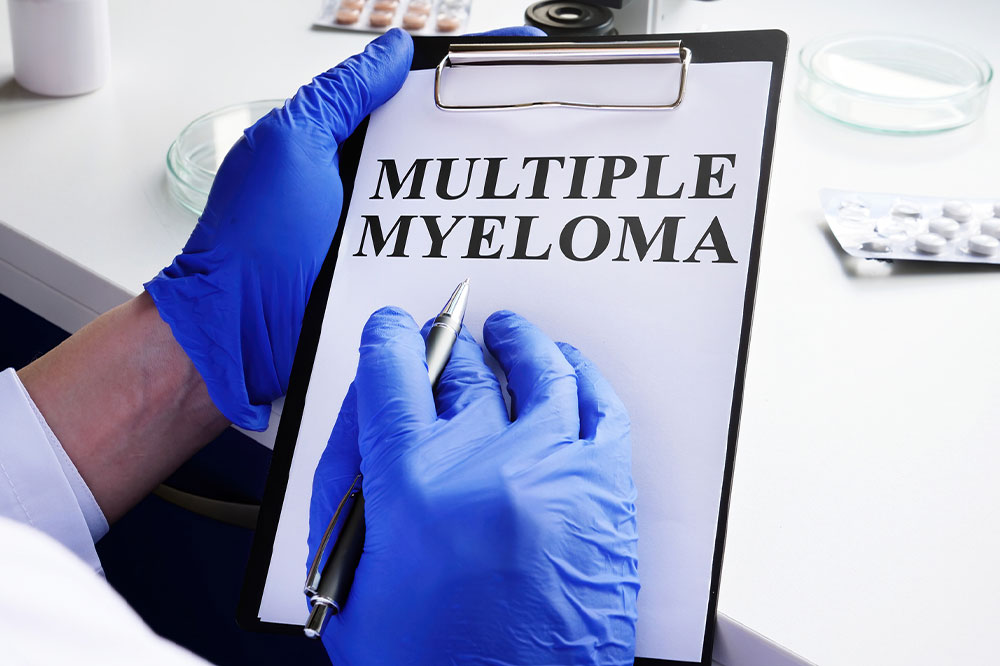
Multiple Myeloma – Symptoms, and Management Tips
Multiple myeloma is a rare type of blood cancer that affects 1 out of 132 individuals. It is known to be more common in men than women, and the symptoms may be visible at a later stage, leading to late diagnosis and complex treatment. This cancer forms in a white blood cell called the plasma cell responsible for fighting off infections. Here are some details on the disease and ways to manage it with some food options.
Symptoms – Common and uncommon
The signs and symptoms of this disease do not show up in the early stage, or even when they do, they come as other health complications which take the focus off the cancer illness. Some signs and symptoms of this disease include:
Anemia: A disease in which the production of blood cells in the bone marrow is affected, leading to a less than an efficient number of red blood cells.
Bone pain: A dull bone pain is usually experienced in the ribs, back, or hips. It usually worsens with movement and remains persistent. This can also weaken the bones leading to fractures. The spine and the bones in the arms and legs are more likely to be affected by this condition. If the spinal cord is affected, it can numb and weaken the legs and feet, causing uncontrollable bladder and bowel movements and the feeling of pins and needles in the body.
Thick blood: Due to multiple myeloma, a person can develop hyperviscosity. This is a condition in which the blood gets thicker than normal due to the excess protein found in the cells. It causes complications like dizziness, headaches, blurred vision, and shortness of breath.
Unusual bleeding: Heavy periods, frequent nosebleeds, and bleeding gums are some telltale signs of possible multiple myeloma. Bleeding is frequent due to the cancer cells attacking the blood-clotting platelets in the body, deeming them dysfunctional.
Increased calcium: In multiple myeloma, it is observed that excess calcium is released into the blood from the affected bones, which can cause complications like stomach pain, sickness, frequent urination, constipation, drowsiness or confusion, and also an extreme thirst.
Frequent infections: This is another telltale sign of multiple myeloma. Due to the compromised immune system, it is easy to catch an infection, and fighting it off becomes even more challenging. This leads to a vicious cycle of frequent infections that can last for weeks or months on end.
Kidney complications: Commonly known as kidney or renal impairment, this condition occurs because of multiple myeloma, eventually leading to kidney failure. Some of the signs of this complication include loss of mass, feeling sick, shortness of breath, lack of energy, itchy skin, swollen ankles or feet or hands, and hiccups that remain persistent.
It is important to speak to a doctor and get a detailed diagnosis of the illnesses. Usually, these symptoms are individual illnesses. However, a doctor can understand and diagnose it better if there are underlying causes of these symptoms that point to multiple myeloma.
Foods to eat to manage multiple myeloma
Fiber: This is essential for gut health and significantly more vital when recovering from multiple myeloma treatments like chemotherapy. Fiber is responsible for breaking down food and helping clear out the bowels. Drinking plenty of water along with prune juice is also well recommended. Other foods with high fiber content include apples, pears, oatmeal, nuts, beans, broccoli, celery, artichokes, whole grains, figs, and prunes.
Bland food: Some people have a bad reaction to the treatment; hence, doctors recommend very light or bland foods like toast, applesauce, bananas, and even rice during the management period. Pudding or mashed potatoes are also recommended, especially if there is an issue with mouth sores. Staying hydrated is essential for managing multiple myeloma treatment and recovery processes.
Green vegetables: This includes broccoli, spinach, bok choy, cabbage, kale, and all other local varieties of green vegetables and fruits. These foods are considered to be highly rich in antioxidants which help in the building of immunity. They are also known to fight off constipation, a common side effect of treatment.
Iron-rich foods: Lean meats, beans, and dark and leafy vegetables like spinach, kale, and broccoli are all good examples of iron-rich foods. Because anemia is a common symptom of multiple myeloma, eating iron-rich foods is essential in treatment and recovery.
Other vitamins and minerals: Some other essentials like vitamin D, fish oil, and folate are suggested by a nutritionist when recovering from the disease. During treatment, these vitamins and minerals are lost due to a lack of proper food intake and even because of the side effects of treatments. Speak to a nutritionist to chart out a food plan that works best for individual needs.
Foods to avoid
Since the disease weakens the immune system, it is recommended not to eat much raw or uncooked food. This includes runny eggs, sushi, unwashed fruits, unpasteurized drinks, and raw meat or fish. Eating these foods may invite infections that will take weeks or even months to cure. However, since the symptoms of multiple myeloma are recurring infections, it can be difficult to manage.
Other management tips
While the treatment can be successful, the cancer may come back in some cases. This relapsed refractory multiple myeloma occurs when the cancer returns, but now no other treatment options are working. Getting a detailed diagnosis from a doctor and working on other management tips is important by making lifestyle changes when the first signs and symptoms are noted. This includes choosing a healthy and active lifestyle that keeps the body fit. Eating the right foods and avoiding too much processed foods ensure the immune system is strong to fight infections or diseases. Speak to a health professional on specific management tips for the same.




